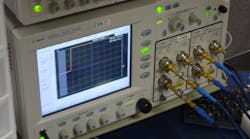Directional Couplers Impact Power Measurements
Directional couplers are typically used when measuring the output power of an amplifier system, as well as the reflected power of load impedance, an antenna, or some other device-under-test (DUT). Their physical characteristics can significantly affect the measurement accuracy of a test setup. While some of these characteristics can be nullified by means of calibration, directional couplers have others that cannot be counterbalanced. In a white paper titled "Influence of a directional coupler’s parameters on the results of forward and reflected power measurements," Rohde & Schwarz describes specifically how directional couplers used in test setups can affect measurement results.
The white paper begins with a general overview of the parameters of a directional coupler. Mathematical definitions for coupling, directivity, and isolation are provided in the document. When performing reflected power measurements in particular, the directivity of a directional coupler can significantly impact results. Because directivity cannot be canceled by means of calibration, high-power measurements can be corrupted as a result of poor directivity.
An example of a typical test setup is presented. In this setup, a directional coupler and a DUT are separated by a specified distance. The reflected wave from the DUT and the coupler’s finite directivity can be represented as two vectors, both of which are added at the directional coupler’s reflection port. The DUT’s reflected wave is transformed by a phase angle, which is determined by the distance between the directional coupler and the DUT, as well as the frequency.
Several mathematical examples are presented in the white paper. The first example calculates the measurement error when using a directional coupler with good directivity. A directional coupler with lower directivity is used in the next example, demonstrating an increased measurement error. Another example further demonstrates how measurement results are affected by the distance between a directional coupler and a DUT by placing two directional couplers at the output of an amplifier system. Finally, the document includes an example to explain how different voltage-standing-wave-ratio (VSWR) values impact measured results.
Rohde & Schwarz, Mühldorfstrasse 15, 81671 München, Germany; (800) 837-8772
